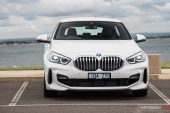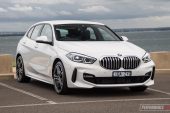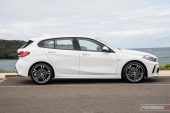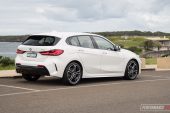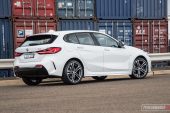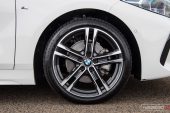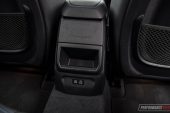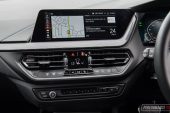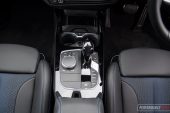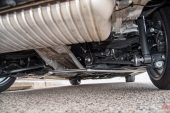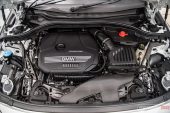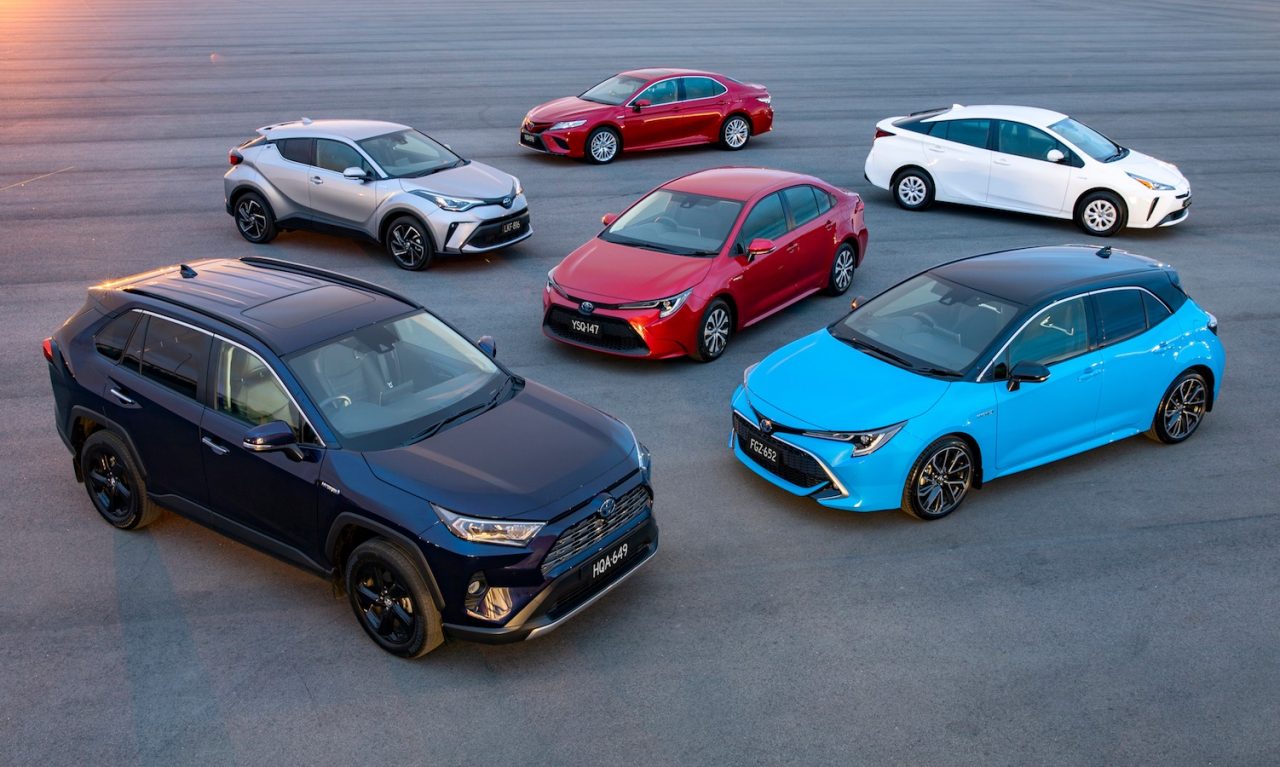Although the humble hatchback is slowly dwindling in sales over consumer preference to SUVs, BMW has refreshed its 1 Series, giving it a new design inside and out, new architecture, and new engine options.
In Australia the latest generation has been launched in two main models; the 118i and the M135i xDrive (review of that coming soon). Faithful BMW enthusiasts will be saddened to see this third generation brings a turn in a new direction; the rear-wheel drive setup from past models has been ditched for a front-wheel drive layout. But for everyone else this means opportunity for more interior space and reduced weight and cost.
Here, we’re giving the 118i a going-over. Just the one ‘M Sport’ trim is available Down Under. It comes with a unique 1.5-litre turbo three-cylinder petrol engine that outputs 103kW of power and 220Nm of torque. It’s paired to a seven-speed dual-clutch automatic transmission, with no manual option. Prices begin at $42,990 for the 118i M Sport, and rise to $64,990 for the class-topping M135i xDrive (excluding on-road costs).
2020 BMW 118i M Sport – THE SPECS
[column width=”47%” padding=”6%”]Engine: 1.5-litre turbo three-cylinder
Output: 103kW@6500rpm / 220Nm@1480-4200rpm
Transmission: Seven-speed dual-clutch auto
Drive type: Front-wheel drive
Wheels: F & R: 18×8.0, 225/40
ANCAP: Five stars
Tare weight: 1290kg
Power-to-weight: 12.52:1 (kg:kW)
Official fuel economy: 5.9L/100km
Economy during test: 7.2L/100km
Fuel capacity/Type: 50L/95 RON[/column] [column width=”47%” padding=”0″]Power efficiency: 17.46kW:L/100km
0-60km/h: 3.76 seconds*
0-100km/h: 8.12 seconds*
60-110km/h: 5.88 seconds*
1/4 mile: 16.11 seconds at 141.0km/h*
Max acceleration: 0.607g
100-0km/h braking: 3.03 seconds at 38.04 metres*
Max deceleration: -1.189g
Decibel at idle: 41*
Peak decibel at 60-100km/h: 74*
Priced from: $42,990[/column][end_columns]
* Figures as tested by PerformanceDrive on the day. Factory claims may be different
2020 BMW 118i M Sport – THE PACKAGE
$43k is a decent amount to pay for a small car, but about average for the premium sector in Australia. For reference, the most affordable Audi A3 currently kicks off from $36,600, and the cheapest Mercedes A-Class starts from $43,900.
Sadly, BMW makes you pay more for features that you would expect to be fitted as standard for this outlay. Distance-controlled cruise control, auto high beam, tyre pressure sensors, proximity key, electrically adjustable front seats, and a list of other common customisable equipment are optional. Android Auto phone integration, rear air vents and a spare tyre (instead of the repair kit offered) are not an option at all.
Fortunately, most areas regarding components and cosmetic features are catered for. For example, the 118i comes with 18-inch alloys, chrome exhaust tips, ambient interior lighting, BMW-labelled puddle lamps, LED lighting everywhere, partially faux leather seats, and BMW-embossed scuff plates are included in the package.
Though, there are a few surprise features we weren’t expecting as standard as well, like forward and rearward collision mitigation, a wireless phone charger, automated steering parking assist, a fully digital instrument display and head-up display, auto dipping side mirrors when reversing, and a total of three USB-C charging ports.
The 118i M Sport comes with what the German brand calls “Live Cockpit Professional” with BMW Operating System 7.0. This is its latest infotainment offering made up of two high-res and easy to read 10.25-inch screens. The centre screen can be controlled by touch or a clickable knob near the gear selector, known as iDrive. We love the clarity of both screens and the level of customisation offered in the menus. Gesture control is available at an additional cost, which allows you to make a specific movement with your hands without touching anything to execute basic functions.
On the design front, the baby Beemer is unmistakably BMW, and better. From front to rear it is a stupendously good-looking car. The famous BMW kidney grilles still remain, but for the first time they are merged in the middle and stretched wide. A big, bulgy BMW bonnet also carries over, which can make it hard to grasp parking distances on the front. But we love the muscular impression left by the sloped, bi-sectioned LED headlights and the sculpted air intakes on the front apron (yes, they are actually real and flow air through to the wheel arches). The high-gloss black trim on the front and rear apron look brilliant too.
The interior flows on that modern and classy design of the exterior. The cockpit shapes around you so you don’t have to reach far for anything. Materials and controls look and feel high in quality. At night time, the backlit door panelling looks superb.
M Sport means sports front seats, which also means heavily bolstered support for cornering. Bigger framed occupants might find it intrusive on the sides of their back, but it holds you in place firmly to maximise control and driver engagement. Our test vehicle had adjustable side bolstering, but we didn’t feel much of a change when adjusting.
Interior space is claimed to be bigger in every direction than the previous generation. And it feels like it, mainly thanks to that transverse engine position and lower centre tunnel. Knee room has increased by 33mm in the back, rear headroom has increased by 19mm, and elbow room has increased by 42mm and 13mm in the front and rear, respectively. The boot space also grows by 20 litres to 380 litres, with 1200L remaining with the rear seats folded down.
2020 BMW 118i M Sport – THE DRIVE
Three cylinders is an odd number to have in an engine. But it has been done before. We think back the humble Daihatsu days, the Fiat 500, and more recently, the BMW-era MINI Cooper and Countryman – which the 1 Series now shares many of its underpinnings with. The outgoing 118i also featured a similar engine as this, although sending power to the rear wheels.
If you look at the 118i’s outputs on paper (or screen) they don’t seem all that thrilling. But when you get behind the wheel it does feel much livelier than you expect. The engine is full of character, sounding almost like it’s not spinning as fast as the tacho shows. 4000rpm sounds more like 3000rpm. So you just want to keep revving it.
Nonetheless, it is admirably willing. It feels happy to be pushed, and power seems to be accessed quickly. If you tackle big hills with spirit, there’s no issue in getting the job done. We adore the thrumming sound, too. There are hints of a roaring five-cylinder when it’s pushed hard. And that adds to the fun. The official 0-100km/h time is 8.5 seconds. Our testing saw a respectable 8.12 seconds. But it’s not just the engine that makes the new 118i M Sport such an enjoyable car to drive.
BMW has obviously made every effort to keep the old motto “Sheer Driving Pleasure” remain true, even with the loss of a rear-wheel drive setup. It exhibits a secure and tight steering feel, with excellent response and precision. This, in combination with a planted track makes it a genuinely fun car in almost any driving environment, especially for something that isn’t intending to be the ‘performance’ variant.
You can confidently aim it at any corner and it holds on all the way through. This means the ride does feel firm like an athletic compact car should. In fact, the M Sport guise means ground clearance has been reduced by 10mm for a more sporty stance. So, you will feel the bumps – even in ‘Comfort’ mode.
In the city and urban conditions, there is a setback that we can’t leave unspoken. The start/stop feature. Firing up a three-cylinder is not as smooth a process as engines with more pistons. This is because there aren’t as many mini explosions taking place and the balance is inherently off – although there are counter-balancing measures in place. So, when you take off after stopping and the engine is powered down, it takes much longer to get going again. And when you find yourself stopping for a very short time and the engine has to resume quickly, it can cough and spit roughly. And it’s not like it is creating a brilliant fuel consumption story either.
Officially, the fuel consumption average is only okay, at 5.9L/100km (for a 1.5L). But we didn’t see our average drop lower than 7.0L/100km. Even though the engine has a small combustion capacity to help conserve fuel, it seems it does need to work relatively hard even when driven gently. It also requires a minimum of 95 RON rated petrol.
2020 BMW 118i M Sport – THE VIDEO
2020 BMW 118i M Sport – THE VERDICT
This new generation 1 Series shows us that BMW knows how to keep the luxury compact car relevant and enticing. Even with the architecture changes you can still have lots of fun in it. With an enthusiastic engine that provides music to the ears, and class-rivalling handling, it can be difficult to resist longer drives.
It’s just a pity that BMW is so crafty with some of the optional extras on its entry models. Comparatively, some of the missing, non-standard features are standard on non-premium equivalents. Once you start ticking these the final price can slide north very easily.
[column width=”47%” padding=”6%”]PROS:
– 1.5T 3CYL sounds brilliant and performs with enthusiasm
– Modern design that’s also unmistakably BMW
– Interior presentation, changeable mood lighting, lots of good tech
– Nice front seats and decent rear legroom
– Athletic and confident road manners for an entry model[/column] [column width=”47%” padding=”0″]CONS:
– Options that shouldn’t be options; adaptive cruise, auto high beam, proximity key
– Start/stop causes roughness and delays with 3CYL engine
– Bulgy bonnet can impair visibility for shorter drivers
– No rear air vents[/column][end_columns]
As always, if you’re thinking about buying a new car don’t forget to click here to speak with our car buying specialists.








